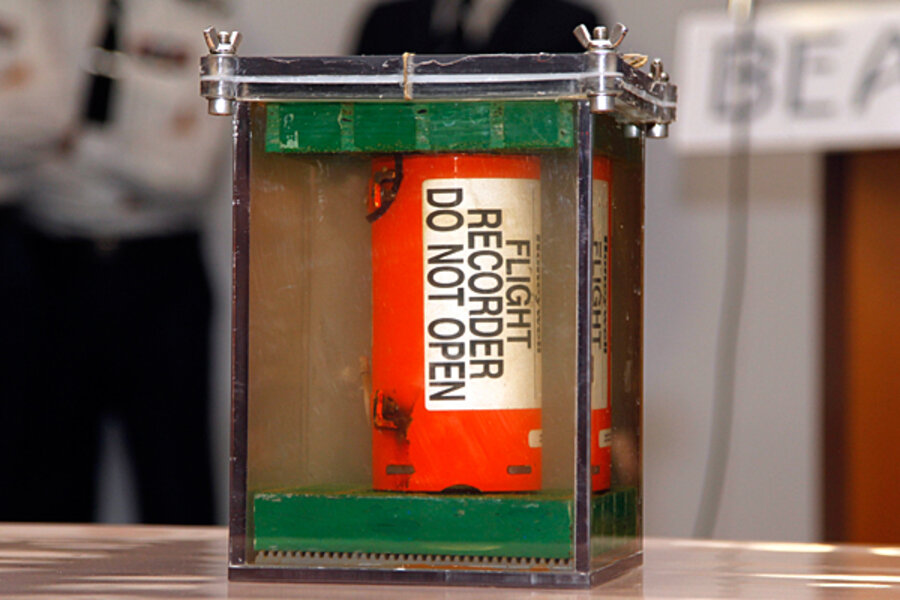Air France black box: Were the Air France Flight 447 pilots at fault for crash?
Loading...
A preliminary report on the Air France Flight 447 crash in the Atlantic Ocean two years ago suggests that while some equipment malfunctioned, the pilots’ inability to respond properly to key instruments sent the plane into a 3.5-minute plunge that killed all 228 people aboard.
The findings by France's Bureau of Investigations and Analyses, based on data recently recovered from the Airbus 330’s black boxes, bolster early suspicions that speed sensors known as Pitot tubes had iced over and malfunctioned. This was a problem on Airbus planes that Air France had been aware of at the time of the crash, which occurred en route from Rio de Janeiro, Brazil, to Paris.
But the findings indicate that it wasn't the malfunctioning speed sensors alone that brought the plane down. They also suggest that pilots had enough information at their fingertips to determine what was happening, suggesting that they were not experienced or not prepared to deal with the sudden crisis that developed two hours into the transatlantic flight. Cockpit displays remained accurate and the engines remained fully functional and responsive to the pilots throughout the flight.
When a plane such as the Airbus 330 in question gets conflicting information from various speed sensors, the autopilot and auto-thrust systems shut down – handing control over to the pilot.
That’s precisely what happened two hours and 10 minutes after Flight 447 left Rio, less than 10 minutes after the captain had left the cockpit for a routine break. He was quickly called back to the cabin to try to help the copilots respond to repeated warnings as the plane stalled, and began falling toward the ocean.
However, it was a 32-year-old co-pilot – the least experienced of three pilots on board – who was at the controls until the final minute of the flight. The plane hit the ocean 4-1/2 minutes after the autosystems disengaged, falling at a rate of nearly 11,000 feet per minute.
The Air France pilots apparently tried to bring the nose of the plane up when it stalled, contrary to the conventional wisdom that pushing the nose down will help increase airspeed and bring an aircraft out of a stall, according to an aviation expert quoted by Bloomberg.
“The question is why the pilot kept giving nose-up inputs when the plane was in a stall,” said Paul Hayes, director of safety at Ascend Worldwide Ltd., a London-based aviation consultant company. “You should put the nose down to recover speed.”
Air France praised the professionalism of the pilots in the final moments of the flights, but numerous reports suggest that the airline had failed to give them the training necessary to respond to such a crisis at high altitude – a fault it is now trying to remedy with new training procedures.
AVweb, a prominent source of online aviation news, reports that the type of stall that occurred over the Atlantic on May 31, 2009, was not unfamiliar to Airbus. Shortly after the crash, investigators found that similar airspeed sensor malfunctions had occurred on 13 other wide-bodied Airbus planes, causing “both the autopilot and autothrottles to disconnect.”
It found that crews took up to one minute to adjust engine thrust, manually, and nine of the episodes led to stall warnings. Airbus and Air France were aware of problem associated with the pitot tubes. The airline received replacement parts (new pitot tubes) six days before Flight 447 crashed. The crash aircraft had not yet been fitted with the new parts. Airbus and certain carriers (including Air France) have since emphasized instruction in high-altitude stall recovery.
The French newspaper Libération on Wednesday published a report highly critical of both Airbus and Air France, based on a document it obtained that was written by five unnamed French judicial experts.
In particular, the experts criticized the lack of a specific procedure for pilots to deal with the icing of airspeed sensors, particularly at high altitude. In order to determine the correct response to such a situation, pilots would have to “dig out a chart” from their documentation – something the Air France pilots clearly didn’t have time to do in a crisis that lasted less than five minutes.
The Wall Street Journal reports that Air France first reported the Pitot icing problem to Airbus in 2008, at which time the two companies discussed solutions and ultimately decided to replace the Pitot tubes with ones less prone to icing – a process that had not yet been completed at the time of the Air France crash in May 2009.
But the Journal also raises the question of whether European aviation regulators may be at fault.
The previous interim report indicated that in late March 2009, less than three months before the crash, European aviation regulators decided that the string of pitot-icing problems on widebody Airbus models wasn't serious enough to require mandatory replacement of pitot tubes.
Air France-KLM reported a profit for the 12 months ending in March this year, improving on a loss of 1.29 billion euros ($1.84 billion) during the previous 12-month period, according to the Financial Times.





